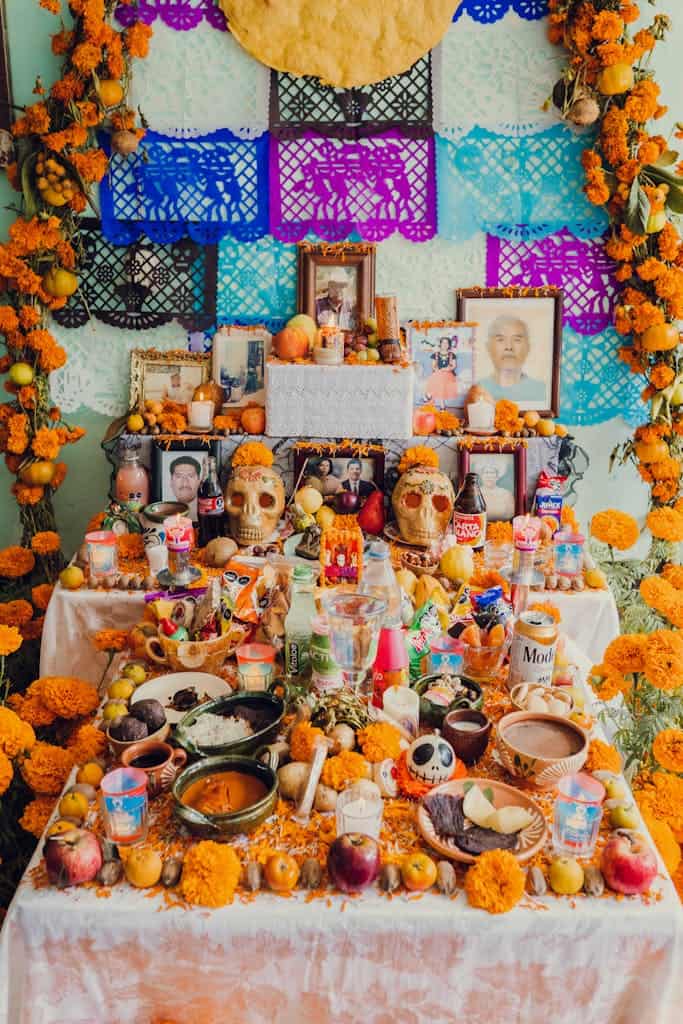The Ultimate Oaxaca Dia de los Muertos (Day of The dead) Guide: Everything You Need to Know
Are you looking to experience the magical Oaxaca Dia de los Muertos celebrations? Get ready for an unforgettable journey into one of Mexico’s most colorful and soulful festivals.
In this comprehensive guide, I’ll share everything you need to know to make the most of your Oaxaca Day of the Dead trip – from the key dates and top events, to where to stay and essential tips I’ve learned from my own experiences at this incredible celebration of life and death. Trust me, by the end of this article, you’ll be counting down the days until you can immerse yourself in the captivating sights, sounds, smells and spirit of Oaxaca’s Dia de Muertos.
Ready to book your Oaxaca Dia de Muertos trip?
Book this 7 day Guided Group Tour— a convenient way and comfortable experience with a near –perfect 5 Star rating. (perfect for solo travelers!)
The Ultimate Oaxaca Dia de los Muertos Guide: Everything You Need to Know
No time to read it all? Here are the highlights:
READY TO BOOK YOUR TRIP?
Best Travel Resources to plan your trip
more helpful travel resources
*This site contains product affiliate links, and I may get a commission, which costs you nothing extra. Thanks for your support
- Oaxaca Dia de los Muertos takes place October 31-November 2 each year
- Book your accommodation and tours months in advance as they sell out
- Must-see events include comparsas (parades), Sand Tapestry competition, visiting cemeteries, and the San Agustin Etla celebration
- Stay in or near downtown Oaxaca City for easy access to festivities
- Visit before the festival to see the marigold flower fields and other preparations
- Embrace the spirit of the holiday and reflecting on loved ones who have passed
Want all the details? Keep reading for the full scoop…
My Top Pick: Oaxaca dia de los muertos tour

Oaxaca dia de los muertos tour
⭐️⭐️⭐️⭐️⭐️

Oaxaca dia de los muertos tour
What is Day of the Dead festival? Dia de muertos en oaxaca
Day of the Dead (Día de los Muertos in Spanish) is a multi-day holiday celebrated throughout Mexico to honor deceased loved ones. The festivities take place from October 31 to November 2 each year.
Despite the skulls and skeletons, it’s not a morbid or scary occasion. The belief is that on these days, the souls of the dead return to visit the living. Families welcome them back with lively celebrations, music, food, drinks, and altars decorated with photos and the deceased’s favorite things.

The origins of Day of the Dead trace back thousands of years to indigenous Aztec rituals worshipping the goddess of death. When Spanish conquerors brought Catholicism in the 16th century, these traditions merged with the Christian holidays of All Saints’ Day and All Souls’ Day.
Today’s Day of the Dead festivities are a colorful, joyful blend of pre-Hispanic and colonial influences unique to Mexico. In 2008, UNESCO even added the holiday to its list of Intangible Cultural Heritage of Humanity.
How Day of the Dead is Celebrated in Oaxaca
While Day of the Dead is observed all over Mexico, the southern state of Oaxaca is especially known for its authentic and elaborate celebrations. Oaxaca’s festivities are deeply rooted in indigenous Zapotec and Mixtec culture.
The soul of Oaxaca Mexico Day of the Dead in lies in the Central Valley villages surrounding the capital city. Each pueblo has its own unique traditions, from sand tapestry competitions to all-night costumed processions.
Here are some of the most notable Day of the Dead customs you’ll encounter in Oaxaca’s Central Valley region:

Vigils in the cemeteries On the nights of Oct 31 to Nov 2, families gather in cemeteries to hold vigils at the graves of deceased loved ones. They decorate the tombstones with marigold flowers, candles, food and drink offerings, and festive items the dead enjoyed in life. It’s believed the strong scent of marigolds and the light of the candles help guide the spirits back.
Comparsas (parades) Lively street processions called comparsas wind through towns and villages day and night. Participants dress up as skeletons, devils, and otherworldly creatures, dancing to live brass bands. Giant papier-mâché puppets and floats shaped like Catrinas and Calaveras (skeletons) bob above the crowds.
Altars/Ofrendas Families create elaborate altars in their homes and public spaces to welcome back the spirits. These ofrendas are adorned with photos of the deceased, marigolds, candles, pan de muerto bread, the relative’s favorite foods and drinks, and symbolic items. Altars have different levels representing the underworld, earth, and heaven.
Sand tapestries Colorful tapestries made of sand, sawdust, flowers and other organic materials pop up on streets and plazas. The most famous of these tapetes de arena is in Zaachila village, where residents compete to make the most creative and heartfelt designs honoring loved ones.
Muerteadas In certain pueblos like San Agustín Etla, costumed characters go door to door on Nov 1-2, collecting offerings for a ceremonial altar. The muerteada culminates in a giant comparsa that lasts from dusk till dawn. Bells and fireworks are set off to “wake the dead.”
When is Day of the Dead in Oaxaca Dia De Muertos?
The core dates of Dia de los Muertos are November 1-2 each year. November 1st honors deceased children (Dia de los Inocentes) and November 2nd honors deceased adults.
However, in Oaxaca, the celebrations really kick off the night of October 31st when the spirits are believed to return at midnight. Festivities continue for several days afterward. To get the full Oaxaca Day of the Dead experience, I recommend arriving by October 28th.

Key dates for dia de los muertos oaxaca :
- October 31: Spirits return, vigils begin in cemeteries
- November 1: Dia de los Inocentes (children)
- November 2: Dia de los Muertos (adults)
- November 3-6: Celebrations continue
Where to Stay in Oaxaca dia de muertos hotels
For maximum convenience, stay in downtown Oaxaca City (Centro Historico), near the Zócalo. You’ll be within walking distance of the main events and decorations.
Top hotel picks in Oaxaca Centro:
- Hotel Quinta Real Oaxaca (luxury) – Beautiful property with a pool in the heart of downtown
- Casa de Sierra Azul (mid-range) – Charming boutique hotel near Santo Domingo church
- Hotel Trebol (budget) – Basic rooms just a few blocks from the Zócalo
Accommodation Tip: Oaxaca hotels book up months in advance for Dia de Muertos. Make your reservations as early as possible for the best selection and prices.
The trendy Jalatlaco neighborhood is another popular area to stay, about a 15-20 minute walk from the Zócalo. Book early to snag a room at these favorites:
- Los Pilares Hotel (luxury) – Stunning modern design and rooftop infinity pool
- Casa de Arte B&B (mid-range) – Stylish B&B in a 17th century building with lovely gardens
If downtown is fully booked, look slightly north in the Reforma or Xochimilco areas, a quick taxi ride away. Good options include:
- Mision de los Angeles (luxury)
Top Oaxaca Day of the Dead Tours & Experiences in Oaxaca
To get you started, here are some top-rated Day of the Dead tours and experiences in Oaxaca:
- 🌼 Visit a marigold flower farm + mezcal tasting tour
- 🪅 Xoxo cemetery vigil + Oaxaca City comparsa night experience
👒 Day of the Dead costume and photo shoot experience - 👨👩👧👦 Oaxacan family altar-building and dinner experience
Many of these tours have limited capacity and sell out months in advance, so be sure to book early! I recommend choosing 1-2 guided experiences, and leaving the rest of your trip open for spontaneous exploration.
Is a Day of the Dead Tour in Oaxaca Worth It?
Short answer – yes, especially if it’s your first time experiencing the holiday! While you can certainly explore many of Oaxaca’s Day of the Dead traditions on your own, there are major benefits to going with a knowledgeable local guide:
Access: Many of the most fascinating Day of the Dead rituals take place in hard-to-reach villages. A tour provides transport and gets you there at the optimal times.
Insight: An experienced guide can explain the history and symbolism behind the different customs, enhancing your appreciation. They may also have personal connections in the host communities.
Convenience: With so many activities happening all over the Central Valley, it’s nearly impossible to fit it all in or know where to be when. A well-planned tour takes the guesswork out so you don’t miss the most special moments.
Safety: Navigating the crowds and logistics on your own can be overwhelming. A guided tour offers peace of mind, especially if you’ll be out late or don’t speak much Spanish.
Of course, not all tours are created equal. When choosing a Day of the Dead tour in Oaxaca, look for ones that:
- Use local guides and give back to the communities they visit
- Limit group sizes so you’re not lost in the masses
- Allow ample free time for independent exploration
- Are transparent about what’s included (food, transport, entrance fees, etc.)
How do I get to Oaxaca City for Day of the Dead?
The most convenient way to get to Oaxaca City is to fly into Xoxocotlán International Airport (code: OAX), located about 20-30 minutes south of downtown.
Several major airlines offer direct flights to Oaxaca from the US and other parts of Mexico, including American, United, Delta, Volaris, Interjet and AeroMexico.
From the airport, you can either take a taxi (approx. 180-250 pesos) or a shared colectivo van (70-100 pesos per person) into the city center. Uber is not available.
Alternatively, you can fly into Mexico City and then take a connecting flight (1 hour), bus (6-7 hours) or drive (5-6 hours) to Oaxaca City. More on that below.
Is there Uber in Oaxaca City?
No, Uber does not currently operate in Oaxaca City. The main modes of transportation are taxis, colectivos (shared vans/pickup trucks) and buses.
Taxis are plentiful and affordable, though not metered, so always agree on the fare before getting in. Most rides within the city cost 40-80 pesos. From the airport, expect to pay around 180-250 pesos.
For cheaper shared rides, flag down a colectivo. You’ll see them cruising the main streets picking up locals along their route. There are also colectivo stands near the Central de Abastos market and 2nd class bus station.
Oaxaca’s bus system is extensive and very affordable (5-10 pesos per ride), but it can be confusing and crowded, especially during Dia de los Muertos. The tourist information kiosks in the Zocalo have free bus route maps.
If you need to book private transportation for an early flight or day trip, your hotel can arrange it, or you can use a service like Didi (Mexico’s answer to Uber).
Best Oaxaca Car Rentals
If you’re comfortable driving in Mexico, renting a car in Oaxaca gives you a lot of freedom to explore the surrounding villages and sites at your own pace. You can pick up and drop off your rental car at the Oaxaca airport.
🚗 Driving tip: Avoid driving at night, always purchase full insurance, and brush up on Mexican road signs and rules before you go.
I recommend reserving your car ahead of time through an aggregator site like Discover Cars or Expedia. They offer competitive rates from major companies like Hertz, Avis, and Europcar as well as reputable local agencies. Compare prices and read the terms carefully before booking.

How to get from Mexico City to Oaxaca City
If your international flight lands in Mexico City, you have a few options for getting to Oaxaca:
Fly (1 hour) – The quickest and most convenient way. Flights from MEX to OAX run frequently throughout the day on Interjet, Volaris, Viva Aerobus and AeroMexico and cost $50-100 USD one way.
Bus (6-7 hours) – The most economical option. Several companies run comfortable, direct overnight buses from Mexico City’s TAPO terminal to Oaxaca City. ADO GL, ADO Platino and OCC are the best. Book in advance around Day of the Dead. Expect to pay 600-1000 pesos each way.
Drive (5-6 hours) – Renting a car gives you the most freedom, but the drive can be intense with winding mountain roads and speed bumps. Follow Hwy 150D to 135D. Leave early to avoid driving in the dark and take breaks. Note there are several tolls along the way (250-350 pesos total).
Oaxaca vs Mexico City Day of the Dead: Which is better?
The great thing is you don’t have to choose! It’s totally doable to experience Day of the Dead in both Oaxaca and Mexico City on the same trip, either as a long day trip or overnight.
In general, Oaxaca’s celebrations are more traditional, intimate and focused on family, while Mexico City’s are larger in scale and oriented towards tourists. Each has a unique flavor:
Oaxaca Day of the Dead
- Emphasis on indigenous Zapotec and Mixtec customs
- Takes place largely in cemeteries and village streets
- Altars and sand tapestries are key elements
- Comparsas (parades) are smaller and more participatory
- Food and crafts have a distinctive Oaxacan flair
- Overall vibe is more solemn and spiritual
Mexico City Day of the Dead
- Grand parade and street party along Reforma Avenue
- Mega altars and art displays in public plazas
- Costume contests, face painting and entertainment
- Catrina flotillas and Calavera sculptures everywhere
- Wider range of local and international food options
- Overall vibe is more festive and whimsical
If you’re short on time, I’d prioritize Oaxaca for a deeper, more culturally immersive Day of the Dead experience. But if you have 7-10 days, combine the two cities for the full spectrum of celebrations.

Things to Do Before Dia de Muertos Oaxaca dia de muertos things to do
I highly recommend getting to Oaxaca several days before Day of the Dead begins. You’ll beat the biggest crowds, have more lodging options, and get to see all the lead-up festivities. The city really starts buzzing with anticipation and preparation the week prior.
🌼 Visit a cempasúchil (marigold) dia de los muertos flowers flower
These blazing orange flowers are the iconic symbol of Dia de Muertos. The marigolds are harvested in late October to decorate altars, gravesites, and the whole city.
For a magical photo op, head to Cultivos el Viejo flower farm in Zimatlán de Álvarez, about an hour from downtown. You can wander through the vibrant marigold fields and even dress up in Day of the Dead attire. Open daily Oct 20-30, 8am-8pm. Admission by 50-100 pesos donation.
How to get to Cempasuchil Marigold Oaxca :
- Bus: Take a bus heading to Zimatlán from Lineas Unidas counter at 2a Poniente 701. Get off at the “El Viejo Flowers” stop and walk 5 min.
- Tour: Book this guided marigold flower field and mezcal tour to sit back and enjoy the experience.
See the elaborate sand tapestries
Sand tapestries, or tapetes de arena, are another Day of the Dead tradition in Oaxaca. Intricate designs are made on the ground using colored sand, flower petals, candles and personal objects related to deceased loved ones.
The indigenous Zapotec village of Zaachila is especially known for its sand tapestry competition. Wander along the designated tapete route on Calle Coquiza, between the cemetery and church, to admire these impressive works of art.
🎨 How to visit the Zaachila tapetes
By bus: Catch a bus bound for Zaachila from the 2a Poniente bus stop. In Zaachila, the tapetes route starts from the cemetery on the west edge of town. Zaachila Tour: Enjoy private transportation and a mezcal tasting with this popular tour from Oaxaca City.

Day of the Dead Itinerary
Oct 31: Vigils in the cemeteries
On the night of October 31st, the spirits are believed to return to the land of the living. Families gather in cemeteries to hold vigils at their loved ones’ graves, decorating them with marigolds, candles, food, drinks and festive items the deceased enjoyed. book a guided tour
Oaxaca’s Xoxocotlán
Cemetery is one of the most famous places to witness Day of the Dead vigils. The whole town has a festive atmosphere with music, food stalls and fireworks. Visitors are welcome to respectfully observe the celebrations.
⚠️ Cemetery Etiquette: Remember this is a sacred tradition for local families. Dress conservatively, ask permission before taking close-up photos, and don’t disturb the altars. Consider making a small purchase from the vendors to support the community.
How to visit Xoxo Cemetery Oaxaca
- Bus: Take the Xoxo bus from Oaxaca’s 2nd class bus station on Bustamante
- Tour: Visit with a guided tour for ease and additional insight
- Taxi: Hail a taxi or moto-taxi, especially if leaving late at night (approx. 150-200 pesos)
Nov 1: Comparsa parades – Oasxaca dia de los muertos parade
On November 1st, Dia de los Innocentes, Oaxaca City comes alive with comparsas – lively street parades featuring giant puppets, brass bands, costumed revelers and more.
The Comparsa de los Muertos is the biggest. It starts around 7pm at Plaza de la Danza and winds through the main pedestrian street of Macedonio Alcalá, up to the Zócalo and Alameda Park. Just follow the crowds and music to find it!
For a more intimate comparsa experience, head to the Jalatlaco neighborhood around 3pm. This traditional parade has a homespun feel as it dances through the narrow cobblestone streets.
Nov 1: Muerteada in San Agustín Etla
For a truly authentic taste of Day of the Dead in Oaxaca, venture to the village of San Agustín Etla after dark on Nov 1st for the Muerteada procession.
Men of all ages dress as spirits and devils, wearing elaborate woven palm costumes covered in bells and mirrors. They go house to house dancing and jingling to “wake up” the deceased. The muerteada lasts all night, culminating in a big brass band parade that ends around 7am.
how to get to San Agustín Etla Muerteada
- Drive: Follow Carretera Federal 190 north for about 45 min from Oaxaca City. Look for parking on side streets.
- Taxi: Catch a taxi from the sitio stand at Trujano and Murguía in Oaxaca. Arrange return transport in advance (approx. 500-800 pesos round trip)
- Tour: Book a night tour package for round trip transportation
Nov 2: More celebrations November 2nd is Dia de los Muertos itself and the biggest day of celebrations. Expect music, fireworks, and festive crowds in the streets, cemeteries and main squares all day and night.
The comparsa parades continue, and families hold final vigils in cemeteries as they bid farewell to the spirits for another year. Soak up the lively atmosphere and reflect on the deeper meanings of the holiday.
Head to the Zócalo to check out the monumental sand tapestry display in front of the Cathedral – a different theme each year.
🎭 Experience a Day of the Dead play
For a unique spin on the holiday, attend the annual Dia de los Muertos play, La Muerte Pies Ligeros (Death with Light Feet). This comedic dance interpretation of the traditions is a hit with adults and kids alike.
Shows take place at the Teatro Macedonio Alcalá on Armenta y López Street from Oct 30 – Nov 6. Buy tickets at the box office.
Tips for Celebrating Day of the Dead Oaxaca
- Bring layers and comfy shoes Oaxaca weather in early Nov tends to be warm and sunny during the day (75-80°F) but quite chilly after dark (45-55°F). Pack lightweight clothing you can layer, along with a warm jacket or thick sweater for nights out.
You’ll likely be doing a ton of walking, so wear your most comfortable closed-toe shoes. The cobblestone streets aren’t sandal-friendly.
- Eat pan de muerto and other seasonal treats Be sure to sample pan de muerto, a special sweet bread made only for Day of the Dead season. You’ll find it at panaderias (bakeries) all over town – look for the round loaves with bone-shaped decor.
Other festive treats to try:
- Calabaza en tacha – candied pumpkin
- Champurrado – chocolate atole (corn drink)
- Chocolate skulls filled with dulce de leche
dia de los muertos makeup painting
Having your face painted like La Catrina is a fun way to get in the Day of the Dead spirit. You’ll see face painting stations set up all along the Alcalá tourist corridor – a design costs about 100-150 pesos.
Many hotels and tour companies also offer professional face painting as part of their Day of the Dead packages, often combined with a photoshoot so you have a unique souvenir.
Dress the part
While full-on Catrina costumes aren’t necessary, many locals and visitors dress up a bit for Day of the Dead with accessories like flower crowns, elaborate hats, skeleton jewelry, lacy shawls, etc.
For the biggest selection, shop at the 20 de Noviembre or Benito Juárez markets, or the seasonal stalls in the Zócalo. Prices are very reasonable – under 200 pesos for most items.
Visit a museum
The cultural museums in Oaxaca have wonderful Day of the Dead exhibitions and activities. A few to check out:
- Museo de las Culturas de Oaxaca – Giant sand tapestries in the courtyards
- Museo Textil – Altars and artwork focused on the tradition’s pre-Hispanic roots
- Museo Belber Jimenez – Folk art and indigenous costumes from around Oaxaca state
Most are free to enter, or cost about 50 pesos. They tend to have extended hours during the Day of the Dead season, often until 8pm.
FAQ About Oaxaca Dia de los Muertos
How far in advance should I plan my trip?
I recommend booking your lodging and tours at least 3-6 months before your trip if possible, especially if you have specific dates or a limited budget. The most popular hotels and guided activities can sell out earlier.
How many days should I spend in Oaxaca for Day of the Dead?
Aim for at least 4-5 days (Oct 30-Nov 3) to experience the essential events and soak up the atmosphere. A full week would be ideal to really immerse yourself and avoid feeling rushed.
Is Oaxaca safe to visit for Day of the Dead?
Oaxaca is generally a safe destination, even during the Day of the Dead crowds. Take the same precautions you would traveling anywhere – be aware of your surroundings, take only registered taxis, guard your valuables. Most people find the vibe very festive and communal.
What if I don’t speak Spanish?
Many Oaxacans in the tourist industry speak some English, and most signage is bilingual in the main areas. However, knowing some basic Spanish phrases will definitely come in handy!
I recommend bringing along a Spanish phrasebook or downloading an offline translator app. Locals always appreciate when visitors make an effort to speak the language.
Do I need to bring anything special to Day of The Dead in Oaxaca?
Where is Oaxaca, Mexico located?
Oaxaca (pronounced wah-HAH-kah) is a state in southern Mexico, about 300 miles (482 km) southeast of Mexico City. It’s bordered by the states of Guerrero to the west, Puebla to the northwest, Veracruz to the north, and Chiapas to the east.
Oaxaca state is known for its indigenous cultures, stunning colonial architecture, rich cuisine, vibrant folk art, and beautiful Pacific beaches. The capital city, Oaxaca de Juárez (referred to simply as “Oaxaca City”), is located in the Central Valley region and is the main hub for the Day of the Dead festivities.
Is Oaxaca a city or state?
Both! Oaxaca is the name of the state, while Oaxaca de Juárez (or Oaxaca City) is the capital and largest city. To avoid confusion when planning your trip, keep in mind that most Day of the Dead celebrations happen in and around Oaxaca City.
Besides your regular toiletries and clothes suited to the season, you may want to pack:
- Reusable water bottle (most tap water isn’t safe to drink)
- Portable phone charger (for all those cemetery photos)
- Sweater/light jacket, warm pajamas (it gets chilly)
- Comfortable walking shoes
- Small first aid kit with OTC meds
- Cash (many places don’t take cards)
Final Thoughts
Oaxaca during Dia de los Muertos is in a league of its own when it comes to experiencing Day of the Dead in Mexico. The depth of tradition, vibrancy of the celebrations, and unique local customs make it an unforgettable immersion into the holiday’s true essence.
Do your trip planning well in advance, but once you arrive, go with the flow and let yourself get swept up in the color, sounds and emotions. Be respectful, but also don’t be afraid to participate.
Most of all, take a moment amidst the revelry to reflect on the deeper meanings – remembering loved ones, accepting mortality, and celebrating life while we have it. That’s the true spirit of Dia de los Muertos that will stick with you long after the marigold petals have blown away.






